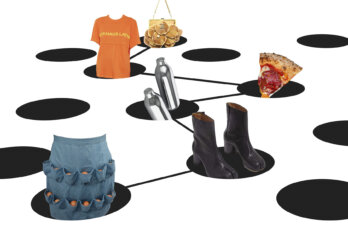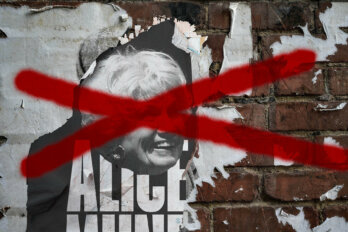Under discussion
Being Mortal: Medicine and What Matters in the End
Atul Gawande
The Death Class: A True Story about Life
Erika Hayasaki
Things I’ve Learned from Dying: A Book about Life
David R. Dow
When I was eighteen, my grandfather took me to raid a dead man’s library. A lifelong bachelor, the deceased had left my grandfather to liquidate his belongings, and I was told to take whatever I liked. Entering that basement apartment in Ottawa, where the man had lived for forty years, I felt an overwhelming isolation. Stacks of books teetered everywhere in those few frigid rooms. A thin mattress on a pullout bed held one restless indentation. Obituaries of silent-film actors were Scotch-taped to the walls. I gathered up several boxes of books, and made off as quickly as possible.
Being a teenager, I hadn’t thought much about what it means to die well, but I knew this wasn’t it. One of the volumes I took that day was Charles Dickens’s The Old Curiosity Shop (1841), with Little Nell’s overwrought deathbed sequence. Surrounded by loved ones, Nell is due any minute for her painless passage to heaven: “Opening her eyes at last, from a very quiet sleep, she begged that they would kiss her once again. That done, she turned to the old man with a lovely smile upon her face . . . They did not know that she was dead, at first.”
Asked how we’d like to die, most of us would describe a scene like the one sentimentalized by Dickens. A 2013 report by the Vanier Institute of the Family found that, among other wishes (we’d like to live forever, of course), most Canadians want to die at home, preferably in our sleep. Yet few of us do. While medicine has ably extended our lives—a century ago, one in four babies in Montreal died before his or her first birthday—it also has “turned the processes of aging and dying into medical experiences, matters to be managed by health care professionals,” observes practising surgeon and New Yorker staff writer Atul Gawande in his 2014 book, Being Mortal: Medicine and What Matters in the End. “And we in the medical world have proved alarmingly unprepared for it.”
The change has been rapid: by 1950, more than half of all deaths in Canada took place in hospitals, up from 30 percent in 1930. In 1994, that figure finally peaked, at 77.3 percent. But instead of learning to “cope with the constraints of our biology,” Gawande argues, we continue to chase the hopeless fantasy of immortality. As he writes, “the default is: Do something. Fix something.” Few of us are able to recognize when enough is enough.
The upshot is that any real-life encounter with death is regarded as a tragic aberration—and just as a sheltered upbringing might lead to poor street sense, so we seem to lack good death sense. What’s more, we have ghettoized the dying in our medical complexes, making it easier than ever to ignore the inevitable. We don’t know what to plan for, nor whose example to follow. Meanwhile, we sleepwalk toward the hospital.
Enter the literature of death and dying, here to awaken us. Forming a personal bond with mortality is probably the only way to begin the reckoning that might prepare us to die well, and the genre seems to be predicated on the idea that the more we contemplate death, the better prepared for it we’ll be.
In the West, the genre originates in Ars moriendi—“The Art of Dying”—two Latin texts that emerged in the fifteenth century, in the aftermath of the Black Death. One of the first books printed with movable type, Ars moriendi initiated a popular tradition of practical instruction on how to die a good Christian death and secure a place in heaven. “For what folly can be imagined greater than to neglect that Art, on which depend our highest and eternal interests? ” asks St. Robert Bellarmine in The Art of Dying Well (1619).
The medicalization of death in the twentieth century corresponded to the rise of secularism, which finds no solace in dreams of eternity, and the latter half of the century witnessed the emergence of a secular death-and-dying literature. Like the self-help genre, which rushed in to satisfy those seeking guidance outside the confines of the church, these secular books offer something similar to what Ars moriendi once did, but without the trappings of faith.
The continued popularity of such books hints at both a timeless need for memento mori—reminders of mortality—as well as the genre’s shortcomings. On Death and Dying, by Elisabeth Kübler-Ross (1969), is still the secular gold standard. Her famous five stages of dying—denial and isolation, anger, bargaining, depression, and acceptance—offered a kind of psychological framework for reckoning with the end. Kübler-Ross was also among the first to identify the problems caused by the medicalization of death. “The more we are making advances in science,” she wrote, “the more we seem to fear and deny the reality of death.” In a passage that would fit just as well in Gawande’s Being Mortal, she observes that a terminal patient “may cry for rest, peace, and dignity, but he will get infusions, transfusions, a heart machine.”
Medical science has gotten better at postponing the inevitable since 1969, and yet, in Kübler-Ross’s parlance, we’ve stalled in denial. More than ever, we seem to need books like Gawande’s, which question medicine’s death-denying imperative and urge us toward acceptance.
For Gawande, this revolution begins at the top. “People die only once,” writes the surgeon. “They have no experience to draw on. They need doctors and nurses who are willing to have the hard discussions.” Sure. But providing patients with options, no matter how multifarious, doesn’t empower them unless they have sound, personal bases on which to make decisions. Before we call upon medical professionals with any kind of self-assurance, we need first to confront mortality.
Erika Hayasaki’s The Death Class: A True Story about Life centres on Death in Perspective, a popular course at Kean University, in New Jersey, taught by nurse Norma Bowe. For an entire school year, Bowe engages students in a prolonged contemplation of mortality, beginning with her gripping description of what physically happens to a dying body: “Hands and feet take on the frigid feel of refrigerated poultry. Arms and legs begin to look pasty.”
Many of the students enrolled in Death in Perspective have endured extreme trauma at young ages. They’ve witnessed murders, escaped gang life, rescued parents from suicide attempts. Their stories give Hayasaki’s title a double meaning that suggests an unlucky class of society living in close proximity to death. Bowe figures as a ministering angel with a sixth sense for suffering, and it becomes apparent that the aim of her course is not really to prepare young people for a good death. Instead, her class functions as an elaborate memento mori that reminds students, “It’s good to be alive, right? ”
The Death Class illustrates the therapeutic effects of contemplating mortality—but despite our bravest attempts to face its reality, death is always something that happens to other people, at other times, in other places. It happens to C. S. Lewis’s wife in A Grief Observed (1961); it happens to Harold Brodkey in his AIDS memoir, This Wild Darkness: The Story of My Death (1996); it happens to Christopher Hitchens in Mortality (2012), and to Pat Kavanagh in Julian Barnes’s Levels of Life (2013). Death also happens to Little Nell, and as far as the reader is concerned these are all literary characters, undergoing literary experiences.
There was a time when everyone knew they belonged to the death class. Immersing oneself in the death-and-dying genre may function as a kind of simulacrum of that era. The characters we encounter in these books stand in for the family and friends we used to lose with awful regularity; and just as people once looked to the church for advice on the art of dying well, secular society may turn to writers for the guidance doctors don’t currently provide. And yet, these books are oddly pleasurable to read, suggesting the genre’s ultimate limitation: reading about what makes us grieve is unlike grief itself.
Perhaps the best we can do is admire a character’s struggle and hope our own conclusion will be written so well. From this perspective, David R. Dow’s Things I’ve Learned from Dying: A Book about Life is among the most successful recent entries in the genre. “My entire life,” says Dow, a death-row lawyer in Texas, “consists of trying to put off the end.” Perhaps only this profession surpasses a doctor’s in sheer grimness: Dow has had to learn “how to tell a man he would be dead in thirty minutes because the appeal was denied.”
Dow’s terse memoir describes a year haunted by deaths: not only of his clients, but also of his father-in-law and, charmingly though less movingly, his dog. In the character of Peter, Dow’s father-in-law, the book finds its depth. Diagnosed with terminal cancer, Peter insists upon a good death, defying the Hippocratic oath and his family’s fantasies of immortality. In an effective touch, his words are italicized, suggesting the almost ghostly status of someone at the border of life and death. Peter perceives his choice as one between freedom and Gawande’s hospital: “I can die on a mountain [or] in diapers in an air-conditioned room.”
A death-row lawyer’s imperative is much like a doctor’s—appeal to the very last—and Dow doesn’t sympathize with Peter’s wishes. In an ugly moment, Dow calls him “decadent”; he and his wife persuade Peter to continue an unwanted course of surgery. Peter accepts the dubious rationale that “the part of my life I own is exceeded by the sum of what others own.” But like the various legal claims Dow files throughout the book, these efforts are futile. Peter dies in hospice care. His eyes close, but, as Dow writes, “he did not look serene.”
In all likelihood, Peter romanticizes death on a mountain: the reality of dying alone might have been frightening and painful. And yet the reader can’t help but see his capitulation as a tragedy. Peter comes close to achieving his own vision of a good death—not one as sentimental as that of Little Nell, but a far cry from an isolated basement in Ottawa or what Gawande calls the “borrowed, fluorescent place” of an ICU. We can’t help but wish he can have it his way, for, knowing nothing of what it means to die, and having been brought no closer by reading these books, we define a good death as we might a good life: as something self-determined.
But then, perhaps this isn’t the criterion at all. Perhaps this will be the last thing we realize.
This appeared in the March 2015 issue.





